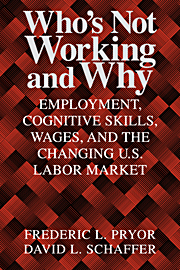Book contents
- Frontmatter
- Contents
- List of tables and charts
- Acknowledgments
- Introduction
- Employment, Cognitive Skills, and Job Displacement
- Wage Levels and Distribution
- Alternative Approaches
- 7 Five Misleading Theories about Joblessness
- 8 Notes on Subjective and Institutional Factors
- Implications and Interpretations
- Appendix Notes
- Bibliography
- Name Index
- Subject Index
7 - Five Misleading Theories about Joblessness
Published online by Cambridge University Press: 25 March 2010
- Frontmatter
- Contents
- List of tables and charts
- Acknowledgments
- Introduction
- Employment, Cognitive Skills, and Job Displacement
- Wage Levels and Distribution
- Alternative Approaches
- 7 Five Misleading Theories about Joblessness
- 8 Notes on Subjective and Institutional Factors
- Implications and Interpretations
- Appendix Notes
- Bibliography
- Name Index
- Subject Index
Summary
In the previous six chapters we present a detailed explanation for the changes that have been occurring in the U.S. economy over the last quarter-century. Our analysis has some similarities with other, more standard explanations in that it emphasizes technological change and an increased rate of return to cognitive skills as two of the important forces behind the other changes. It differs, however, from alternative explanations by placing more significance on the combination of exogenous shifts in labor supply (for instance, educated women choosing to enter the workforce) plus downward “stickiness” in wages. It also differs by suggesting that the increase in the rate of return to a college degree is not as unambiguously large as other studies have suggested.
Throughout the previous chapters, we show that our explanation “fits the facts” closely. It is possible, however, that other explanations explain these patterns just as well, or perhaps even better. In this chapter and in Chapter 8 we examine most of the major alternative explanations and show that they all have difficulty explaining some of the key empirical results.
The five most popular theories explaining the falling employment rates of less-educated males focus on: (a) technological change; (b) structural changes in production and productivity; (c) imports from low-wage nations; (d) immigration; and (e) spatial mismatch of people and jobs. Although all five have some merit, in this chapter we argue that they play only minor causal roles in determination of employment rate changes. In the next chapter we focus on subjective and institutional factors that some have also used to explain labor market changes.
- Type
- Chapter
- Information
- Who's Not Working and WhyEmployment, Cognitive Skills, Wages, and the Changing U.S. Labor Market, pp. 170 - 204Publisher: Cambridge University PressPrint publication year: 1999



